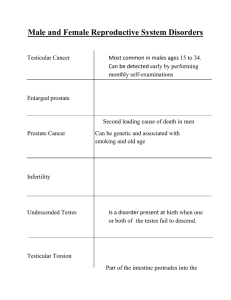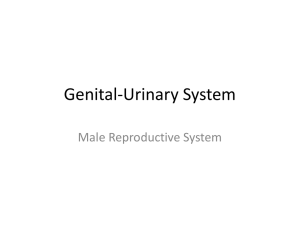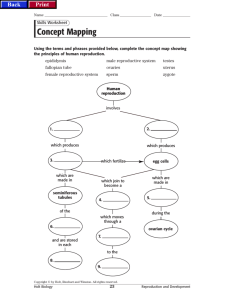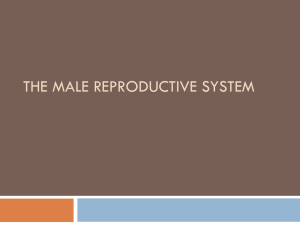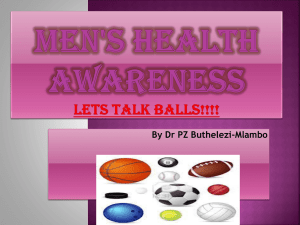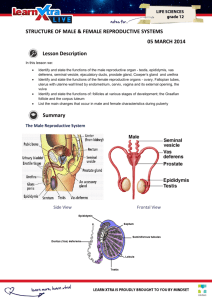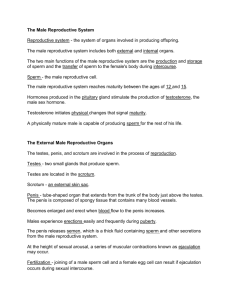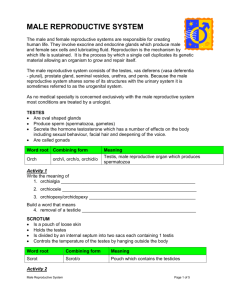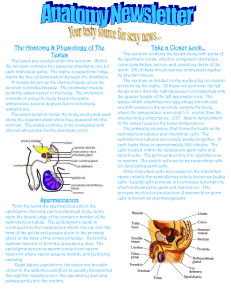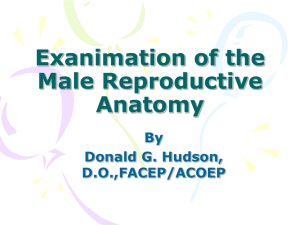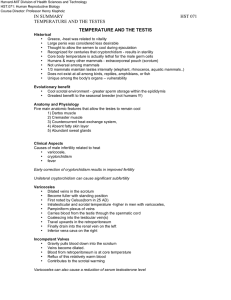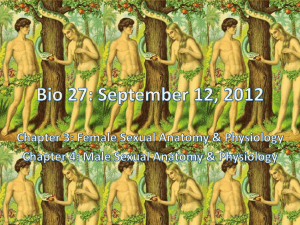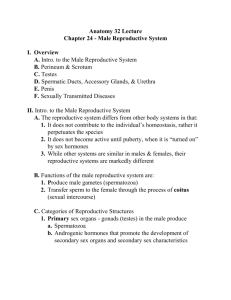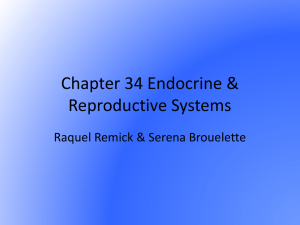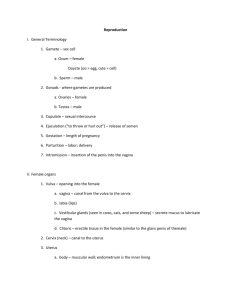Academic Foundation Reproductive System
advertisement
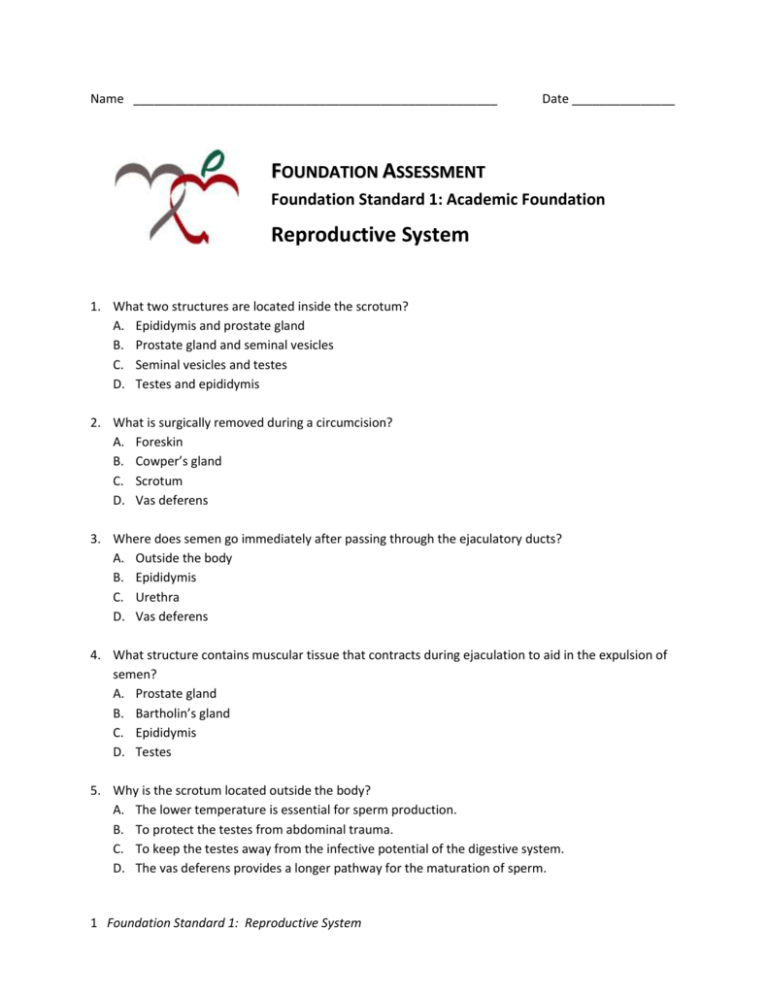
Name _____________________________________________________ Date _______________ FOUNDATION ASSESSMENT Foundation Standard 1: Academic Foundation Reproductive System 1. What two structures are located inside the scrotum? A. Epididymis and prostate gland B. Prostate gland and seminal vesicles C. Seminal vesicles and testes D. Testes and epididymis 2. What is surgically removed during a circumcision? A. Foreskin B. Cowper’s gland C. Scrotum D. Vas deferens 3. Where does semen go immediately after passing through the ejaculatory ducts? A. Outside the body B. Epididymis C. Urethra D. Vas deferens 4. What structure contains muscular tissue that contracts during ejaculation to aid in the expulsion of semen? A. Prostate gland B. Bartholin’s gland C. Epididymis D. Testes 5. Why is the scrotum located outside the body? A. The lower temperature is essential for sperm production. B. To protect the testes from abdominal trauma. C. To keep the testes away from the infective potential of the digestive system. D. The vas deferens provides a longer pathway for the maturation of sperm. 1 Foundation Standard 1: Reproductive System 6. What is the function of the epididymis? A. To secrete testosterone. B. To store sperm until they mature. C. To hold the testes. D. To act as a passageway for sperm from the urethra to the penis. 7. Where in the male reproductive system is testosterone produced? A. Ejaculatory ducts B. Seminal vesicles C. Testes D. Prostate gland 8. A man who receives a mumps vaccination is less likely to get: A. Testicular cancer. B. Prostate cancer. C. Cryptorchidism. D. Orchitis. 9. A 65 year-old healthy male begins to have difficulty starting to urinate, urinary frequency, and nocturia. What MOST LIKELY is the cause? A. Prostatic hypertrophy B. Testicular cancer C. Epididymitis D. Orchitis 10. Occasionally, one or both testes do not descend properly before birth. This condition is known as: A. Circumcision. B. Cryptorchidism. C. Orchitis. D. Epididymitis. 11. Testicular cancer is most common in what age? A. Elementary boys B. High school boys C. Young adult men D. Men over 65 years-old 2 Foundation Standard 1: Reproductive System 12. The female gonads are the: A. Ovaries. B. Fallopian tubes. C. Follicles. D. Mammary glands. 13. What happens when a follicle ruptures? A. Menstruation B. Menopause C. Ovulation D. Lactation 14. Where does fertilization of an ovum usually take place? A. In the ovary B. In the cervix C. In the uterus D. In the fallopian tube 15. What reproductive structure is described as a hollow, muscular, pear-shaped organ? A. Uterus B. Vagina C. Perineum D. Ovary 16. Which of the following is part of the uterus? A. Areola B. Perineum C. Fimbriae D. Fundus 17. During menstruation, the bleeding is the result of: A. Detachment of the myometrium. B. Deterioration of the endometrium. C. A ruptured follicle. D. A ruptured fallopian tube. 18. What part of the external female genitalia provides padding for the public bone? A. Clitoris B. Labia minora C. Mons pubis D. Perineum 3 Foundation Standard 1: Reproductive System 19. When does a woman experience lactation? A. During fertilization B. After ovulation C. During labor and delivery D. After childbirth 20. At what age does the American Cancer Society recommend a baseline mammogram for women? A. 20 – 30 years old B. 35 – 40 years old C. 45 – 50 years old D. 55 – 60 years old 21. What would cause a positive Pap smear? A. Herpes B. Endometriosis C. Cervical cancer D. Breast cancer 22. A woman who is NOT sexually active could still develop: A. Endometriosis. B. Chlamydia. C. Gonorrhea. D. Syphilis. 23. Acquired Immune Deficiency Syndrome can be prevented by: A. A vaccine. B. Antibiotics. C. Diet and exercise. D. Avoiding risky behavior. 24. This disease can be cured with antibiotics in the first two stages, but untreated, can cause damage to the heart, brain damage, mental disorders, deafness and blindness. What is the disease? A. Syphilis B. Herpes C. Uterine cancer D. Chlamydia 25. What do the initials PID stand for? A. Pelvic Immune Disorder B. Pelvic Inflammatory Disease C. Perineal Inflammatory Disorder D. Perineal Immune Deficiency 4 Foundation Standard 1: Reproductive System
